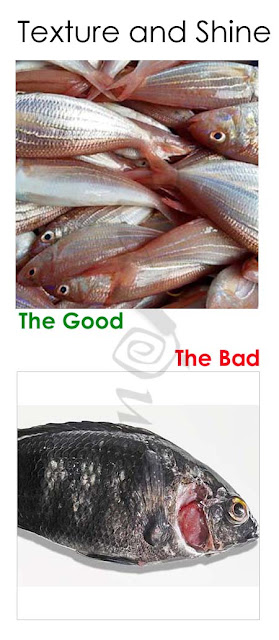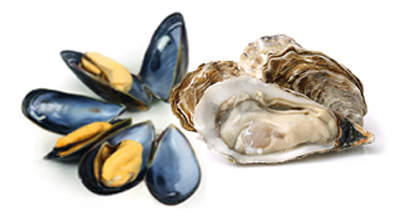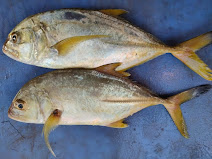Fishes come in all sizes, shapes and each variety has its distinct flavours.Fish is a versatile food that you can prepare in a wide variety of ways, be it baked, steamed, poached, grilled, deep or shallow frying. Fishes are most commonly consumed food across the world for its nutritional proteins, Omega 3 fats and iodine, Also, eating fish regularly reduces the risk of many diseases. A fresh fish however cooked definitely is a thing to relish.
So how to get the ' Just out of the Ocean' experience of tasting a fresh fish? We need to go fishing , lol. Well ALMOST fresh even though not directly from ocean to plate. Here are few thumb rules you have to follow the next time you visit a fish counter. Fish is highly perishable item and gets spoilt very fast , if not maintained at a proper temperature. Just follow these tips for a good buy.
Here's LIST OF INDIAN FISH NAMES WITH PHOTO 👈
📜 List of top 20 fishes we should avoid eating
📜 What is the healthy way to cook a fish ?
📜 Do you know the National Fish of India ?
EYE TEST
Eyes are windows to the sole. Look for CLEAR bright, glossy, bulged (convex) and dark eyes. Sunken, red, glazed or cloudy white eyes with gray dullness are a real no-no.
RED GILL DELIGHT
Probably the oldest trick to buy a fresh fish is to check the gills. Bright scarlet gills/bright pink or red on a fish means it’s freshly caught. The gills should feel clean and not sticky or slimy. A dull brick or dark brown color is an old fish. Sticky gills sometimes indicate use of formalin solution.
Beware 👎:
- A red dye is often applied to the gills to make appear fresh , so beware.
- If formalin is used the fish retain the red color of the gills. It could be a false symbol of freshness.
- Mostly expensive fishes are chemically laced to look fresh for weekends when the demand is quite high.
In most Asian fish markets, fishes are contaminated with highly toxic Formalin and Ammonia for better shelf life, as ice is expensive and has to be replaced frequently. These fishes smell and when cooked taste of chemicals but very hard to point out.
For formaldehyde contaminated fish look out for flies near the fishes, As the old saying goes, 'Always go to a fish shop with flies around, it tells the fish is not contaminated'. Ammonia is used to slow melting of ice and formalin is used to preserve the fish for long shelf life. Both chemicals are quite toxic for human intake.
FIRMNESS TEST
Fresh fish has a rigid body, a hard and firm form means freshness. If the fish is soft/mushy
means fish is old. Finger tips shouldn't
leave an impression when poked, it should bounce back to normal when pushed with a finger. Belly of a fresh fish is shiny, firm and undamaged. If its bursting out its an old one.
Beware 👎:
- Old Fishes are sometimes frozen to make it firm and hard,
to misled people.
- A rubbery flesh mostly suggest formalin preservation.
SNIFF TEST
A fresh fish will have clean, salty smell and not smell fishy. They should have no pungent smell. Rotten fish have foul nasty smell. A smell of chemicals suggests the presence of formaldehyde solution.
Beware 👎:
- While selling in heaps rotten fishes are often mixed with fresh ones.
TEXTURE AND SHINE
The
skin should be metallic, shiny, moist and clean looking. No brown spots or patched, it shows the sign of
decay. must have an appearance of a live fish. A dull looking fish with fallen scales means
OLD. Fresh fish have most scales intact and adhere tightly to the skin, A fresh fish skin glistens with a rainbow sheen
FINS AND TAILS
Many fish traders take care to preserve only the meat of the fish using ice and formalin. Have a look at the fins and tails, which will reveal the freshness of the fish. If the fins have started to shrivel, dry, brittle or decay say no to the fish. Torn fins suggests the fish was mishandled
The above picture shows how the shine, eyes, firmness, colour of the body, tail and fins have gradually changed within a span of 10-15 days.
COLOR OF THE SLICES
Fishes fade in color once they are past their prime. When buying fillets look for neat, moist, trim , bright and firm fillets with white translucent appearance (for white fish). The fillets should have no cracks. There should be no browning around edges, Poor quality fish is soft, limp and tears on pressure, not holding tight to the fish muscles. Fish muscle is of two kinds, light muscle and dark muscle. A sniff is important here, there should be no pungent smell. Prepacked fillet should contain minimum of water pooling
CRABS & LOBSTERS
Fresh crabs and lobsters should be lively and frisky. Should be heavy for their size. If the crab is sulking in a corner of the tank, its not worth putting in your basket.
PRAWNS AND SHRIMPS
Should be firm and have mild odour, The shell should not have black spots and should be translucent for most varieties with a greenish, bluish or pinkish tint. When cooked the meat should be firm and less smelly
SHELL FISH
Select shell fish (Clams, Mussels, Oyster) which are tightly closed without any gaps/cracks. Once cooked if the shell fish doesn't open, better throw them away
SQUIDS
Squids have clear eyes and meat should be firm and untorn. A fresh squid has reddish brown spots but if it decays, its flesh turns yellow.
AROMA OF COOKED FISH
Its already late, but trust your senses. Fresh fish do not taste bad or bitter in deep colored portion. There should be no foul smell while cooking. A good fish when cooked has a rich aroma, if fried or grilled the inside flesh would be bright white.
A QUICK SUMMARY
Lastly fresh fish will come at higher price unless the whole market has a similar catch
.
Continue Reading...
 An important difference between prawns and shrimps, is in the way the segments of the abdomen (tail) overlap. Shrimps have curled body compared to flat body of prawns. The Prawn is transparent with long legs and the Shrimp is the sandy colored. Prawn’s legs are longer than shrimp’s legs.
An important difference between prawns and shrimps, is in the way the segments of the abdomen (tail) overlap. Shrimps have curled body compared to flat body of prawns. The Prawn is transparent with long legs and the Shrimp is the sandy colored. Prawn’s legs are longer than shrimp’s legs. 





 What's the difference between a Prawn and a Shrimp?
What's the difference between a Prawn and a Shrimp?























